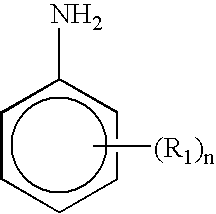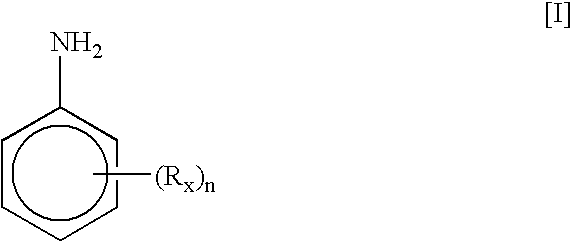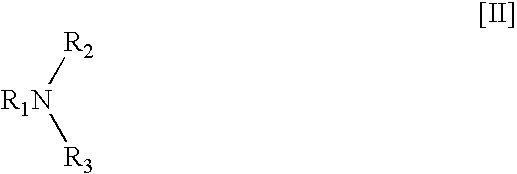Unleaded aminated aviation gasoline exhibiting control of toluene insoluble deposits
a technology of aminated aviation gasoline and toluene insoluble deposits, which is applied in the petroleum industry, liquid carbonaceous fuels, fuel additives, etc., can solve the problem of insufficient to meet the needs of 98+ mon high octane avgas
- Summary
- Abstract
- Description
- Claims
- Application Information
AI Technical Summary
Problems solved by technology
Method used
Image
Examples
example 1
[0047] This example illustrates the toluene insoluble deposit formation of aviation alkylate fuels containing 4-isopropyl phenyl amine and the ability of different additives to control the toluene insoluble deposits. The fuel, unless otherwise indicated was alkylate containing 11 wt % 4-isopropyl phenyl amine.
[0048] The test was run in accordance with the procedure reported in U.S. Pat. No. 5,492,005. In the test n-heptane insolubles and toluene insolubles were measured and the fouling potential determined. In the test a metal nub is cycled between 150° C. and 300° C. in 9 minute cycles. About 40 ml of fuel is dripped on the nub in an air atmosphere. The nub is weighed before and after feed is dripped on it to five decimal places (0.00001 g). It is then washed with n-heptane and weighed and with toluene and weighed to determined the n-heptane and toluene insolubles. The results are presented in Table 1.
[0049] Because of the nature of the test differences within 0.03 mg are conside...
example 2
[0052] In this Example the various deposit control additives were evaluated for their effect on the water separation properties of animated aviation gasoline fuels. The base fuel was alkylate containing 11 wt % tert butyl phenyl amine and 11 wt % toluene. The water separation was determined using MSEP / water shedding test method ASTM D3948 Rev A setting B and using the yellow cell. This test was designed to rate the ability of aviation turbine fuels (JP-4 not gasoline) to release entrained or emulsified water when passed through fiber-glass coalescing material. Although designed and intended for different fuels the test was modified herein in that it was applied to a gasoline and utilized as a convenient way to determine whether aviation gasoline fuels containing the recited additives could perform adequately in terms of water separation. In the test a fuel is mixed with water, passed through the coalescing cell then is placed in a turbidity meter. A more clear fuel will transmit mor...
PUM
 Login to View More
Login to View More Abstract
Description
Claims
Application Information
 Login to View More
Login to View More - R&D
- Intellectual Property
- Life Sciences
- Materials
- Tech Scout
- Unparalleled Data Quality
- Higher Quality Content
- 60% Fewer Hallucinations
Browse by: Latest US Patents, China's latest patents, Technical Efficacy Thesaurus, Application Domain, Technology Topic, Popular Technical Reports.
© 2025 PatSnap. All rights reserved.Legal|Privacy policy|Modern Slavery Act Transparency Statement|Sitemap|About US| Contact US: help@patsnap.com



